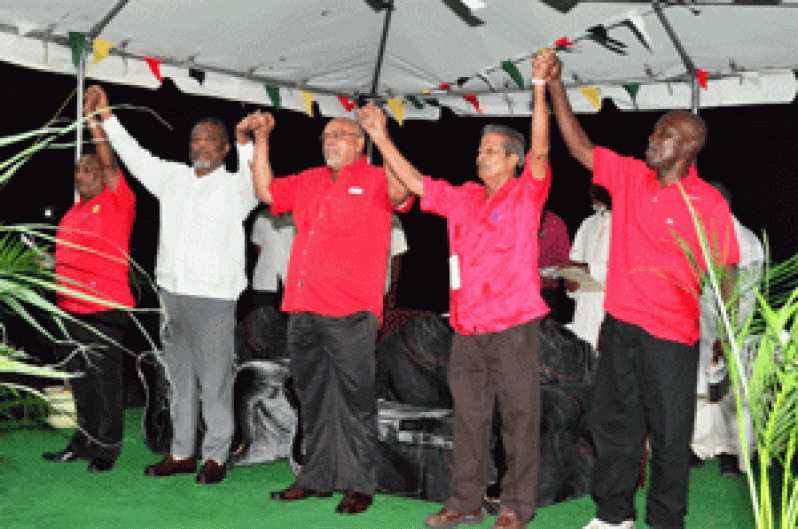PRESIDENT Donald Ramotar on Saturday last reiterated his call for unity in the sugar industry and commitment to working with the industry and all associated stakeholders to ensure that it continues to play a central role in the economy in order that many of the services that were provided in the past, can continue.
 President Ramotar made this call at the 64th anniversary of the commemoration of the death of the five Enmore sugar workers who were killed by colonial police in 1948 as they protested for better working conditions.
President Ramotar made this call at the 64th anniversary of the commemoration of the death of the five Enmore sugar workers who were killed by colonial police in 1948 as they protested for better working conditions.
“Let us begin to work together to build the industry, our country and to make it a better place for all the people in this country,” the Head of State said.
Speaking specifically on Guysuco, President Ramotar said, “…if you were to look across this nation you would see that Guysuco has trained more skilled workers not only for themselves but for other industries, many overseas have benefitted from their skills.”
Addressing the large gathering, the President said, “We are here to commemorate the lives of the Enmore Martyrs …that incident on June 16, 1948 has become one of the most important dates in our country’s history, and one of the most important dates in the calender of working class struggles in our country,” the Head of State said.
He added that what took place at Enmore, then, was a coming together of several strands of struggle that were taking place both in Guyana and worldwide.
“In that same year, there was a huge strike in the bauxite industry and a big strike in the transport sector…the world had just emerged from the second world war and there was a mighty thrust in anti-colonial struggles taking place,” the Head of State explained.
“Many of the things that were happening already in the world like workers having the right to vote for their own trade unions were denied our people here…it went on to make bigger demands- the demands that were started by the Political Affairs Committee,” the Head of State said.
He added that the Enmore struggle ignited the national movement for independence, which 18 years later realised its objective. “That struggle also focused the attention and need for democracy and inspired us as we fought against the dictatorship in Guyana- that is why Enmore will always remain very significant in our country’s history,” President Ramotar said.
“That struggle also focused the attention and need for democracy and inspired us as we fought against the dictatorship in Guyana- that is why Enmore will always remain very significant in our country’s history,” President Ramotar said.
The Head of State said that there was a coming together to fight for the rights of the people, moreso the sugar workers- which was successful because of the strength of unity, therefore everyone must play their part to ensure that the survival and transformation of other industries in Guyana.
President of the Guyana Labour Union, Winston Joseph said he is reminded of the Enmore Martyrs’ ultimate sacrifice that was made as they paved the way for a better tomorrow, not only for sugar workers but against the plantocracy and colonial rule of an independent Guyana.
“The battle they fought even though it created drastic changes- the struggles still exist today in a different form… on this anniversary, let us work together to improve the workers’ standard of living and a better Guyana,” Joseph said.
President of the Guyana Agricultural Workers Union (GAWU), Komal Chand said that Guyanese must see and connect the Enmore strike and the martyrdom of the five workers with other working people’s struggle and heroism of other workers which make up Guyana’s proud history.
Background of struggle
In April 1948, cane cutters in British Guiana, went on strike calling for the replacement of “cut and load” with a “cut and drop” system by which the cane cutters should cut the cane. They also demanded higher wages and improved living conditions on the sugar estates. However, the real aim of the strike was to demand recognition of the Guyana Industrial Workers Union (GIWU) as the bargaining union for the field and factory workers on all the sugar estates in the country.
On June 16 the SPA and the MPCA met to discuss the issues, but no satisfactory agreement was reached, in any case the workers felt very strongly that that union was betraying their interests.
Early on the morning of June 16, a crowd of about 400 workers gathered outside the factory at Enmore for a protest and picketing exercise. By 10.00 a.m. the crowd had grown to between 500 and 600 persons. Several persons managed to enter the compound on the rear of the factory. The policemen tried to push back the crowd, but after this effort failed, they opened fire and five workers were killed and 14 others were injured.
Lallabagee Kissoon, 30 years old, was shot in the back; 19-year-old Pooran was shot in the leg and pelvis; Rambarran died from bullet wounds in his leg; Dookhie died in hospital later that day; and Harry died the following day from severe spinal injuries. These men, through the years, became known as the Enmore Martyrs. (GINA)



.jpg)








